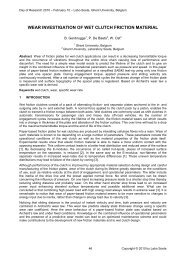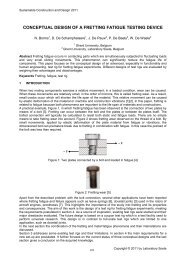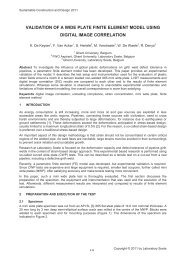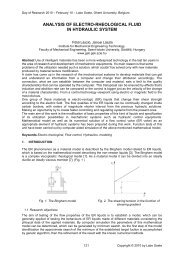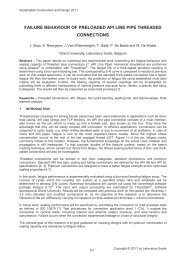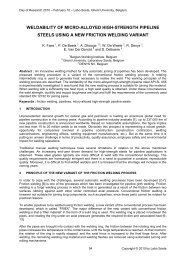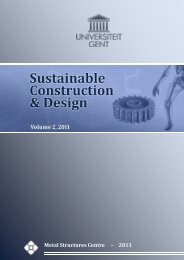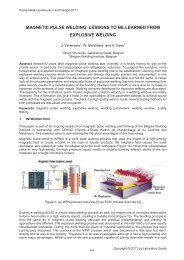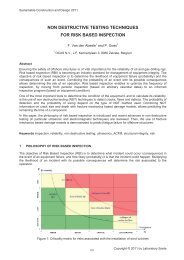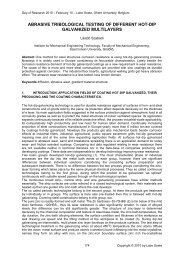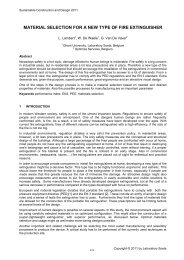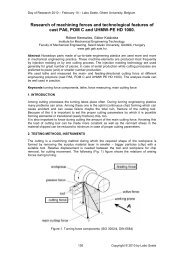F - 5th International Conference on Sustainable Construction and ...
F - 5th International Conference on Sustainable Construction and ...
F - 5th International Conference on Sustainable Construction and ...
You also want an ePaper? Increase the reach of your titles
YUMPU automatically turns print PDFs into web optimized ePapers that Google loves.
Day of Research 2010 – February 10 – Labo Soete, Ghent University, Belgium<br />
boundary c<strong>on</strong>diti<strong>on</strong>. The prescribed interference was applied gradually until it reaches its maximum value;<br />
then it was removed gradually in order to simulate the unloading process. The FE results are also<br />
compared to the analytical soluti<strong>on</strong> in Figure 3, for three different overstrain values, namely Φ = 25, 60 <strong>and</strong><br />
R R<br />
R<br />
m i<br />
100 % ( 100%<br />
).<br />
i<br />
R i<br />
R s<br />
R o<br />
Figure 3. Residual hoop stress in an autofrettaged tube (MPa)<br />
3 HEAT TRANSFER ANALYSIS<br />
In heat transfer analysis, the degree of freedom is usually temperature. In general, there are two types of<br />
analysis, namely steady state analysis <strong>and</strong> transient analysis. In steady state analysis, the temperature<br />
distributi<strong>on</strong> <strong>and</strong> related quantities are determined under steady state c<strong>on</strong>diti<strong>on</strong>, i.e. variati<strong>on</strong> over time is<br />
ignored. Whereas in transient analysis, the temperature distributi<strong>on</strong> <strong>and</strong> related quantities are determined<br />
at different time intervals. The governing differential equati<strong>on</strong> for isotropic heat transfer in 3-D space, also<br />
known as the heat equati<strong>on</strong>, is given by:<br />
2 2 2<br />
T<br />
K T T T <br />
<br />
<br />
<br />
(8)<br />
2 2 2<br />
t<br />
cp<br />
x<br />
y<br />
z<br />
<br />
Where t is time, K is thermal c<strong>on</strong>ductivity (J/m.s. o C or W/m. o C), is mass density (kg/m 3 ), c<br />
p<br />
is specific<br />
heat capacity (J/kg. o C) <strong>and</strong> T is temperature, which is functi<strong>on</strong> of space <strong>and</strong> time. Applying the variati<strong>on</strong>al<br />
formulati<strong>on</strong> or weighted residual formulati<strong>on</strong> to Equati<strong>on</strong> (8), the FE c<strong>on</strong>ducti<strong>on</strong> heat transfer equati<strong>on</strong> is<br />
obtained as:<br />
T<br />
<br />
C<br />
K<br />
T q<br />
(9)<br />
<br />
t<br />
<br />
<br />
Where K is the c<strong>on</strong>ductivity matrix, C is the specific heat matrix, T is the temperature vector,<br />
T<br />
is<br />
<br />
t<br />
<br />
<br />
the rate of change of temperature vector over time <strong>and</strong> q is the heat flux vector. Equati<strong>on</strong> (9) is solved<br />
using numerical integrati<strong>on</strong>, usually Euler integrati<strong>on</strong> scheme, in which the derivative of temperature with<br />
respect to time is approximated as<br />
T T(<br />
t t)<br />
T(<br />
t<br />
<br />
) , where T( t t)<br />
is the temperature at time step<br />
t<br />
t<br />
t t <strong>and</strong> T (t)<br />
is the temperature at time step t. For steady state analysis, the problem is independent<br />
of time, thus the term c<strong>on</strong>cerned with time in Equati<strong>on</strong> (9) is eliminated, <strong>and</strong> the FE equati<strong>on</strong> is reduced to:<br />
K T q<br />
(10)<br />
An example of steady state c<strong>on</strong>ductivity heat transfer FEA is a Railko Marine Bearing [7]. The bearing<br />
c<strong>on</strong>sists of two layers, namely a backing <strong>and</strong> a liner. The backing has a thermal c<strong>on</strong>ductivity of 0.35<br />
W/m. o C <strong>and</strong> a thickness of 28 mm, while the liner has a thermal c<strong>on</strong>ductivity of 0.22 W/m. o C <strong>and</strong> a<br />
thickness of 21 mm. The average inner diameter is 740 mm <strong>and</strong> the outer diameter is 838 mm. 2-D plane<br />
heat transfer elements were used to model the two layers with mesh refinement near sharp corners <strong>and</strong> at<br />
interface. The inside temperature was 100 o C, whereas the outside temperature was 30 o C. Figure 4 shows<br />
the steady state temperature distributi<strong>on</strong> in the bearing.<br />
32 Copyright © 2010 by Labo Soete



